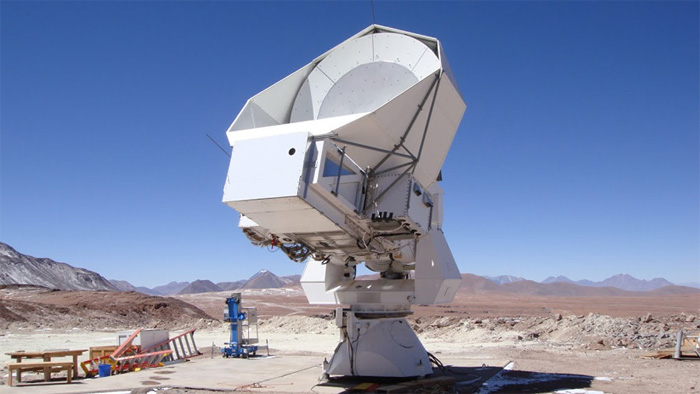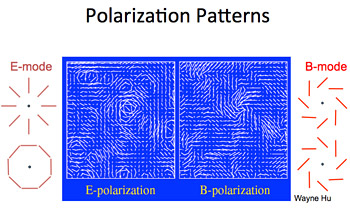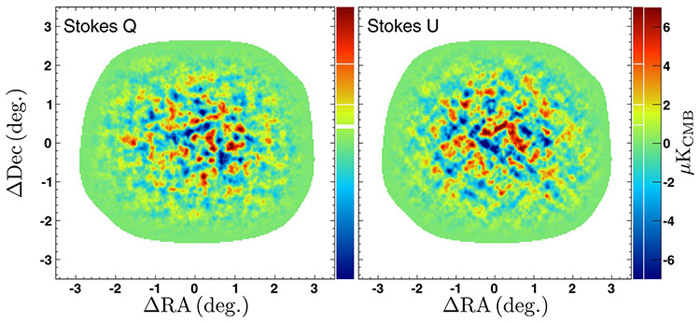.

The Huan Tran Telescope in the Atacama Desert of Chile. The POLARBEAR microwave bolometers are mounted on the telescope to study the polarization of light from a period 380,000 years after the Big Bang.
.
BERKELEY —An international team of physicists has measured a subtle characteristic in the polarization of the cosmic microwave background radiation that will allow them to map the large-scale structure of the universe, determine the masses of neutrinos and perhaps uncover some of the mysteries of dark matter and dark energy.

In a paper published this week in the Astrophysical Journal, the POLARBEAR consortium, led by UC Berkeley physicist Adrian Lee, describes the first successful isolation of a “B-mode” produced by gravitational lensing in the polarization of the cosmic microwave background radiation.
Polarization is the orientation of the radiation’s electric field, which can be twisted into a “B-mode” pattern as the light passes through the gravitational fields of massive objects, such as clusters of galaxies.
“We made the first demonstration that you can isolate a pure gravitational lensing B-mode on the sky,” said Lee, POLARBEAR principal investigator, UC Berkeley professor of physics and faculty scientist at Lawrence Berkeley National Laboratory (LBNL). “Also, we have shown you can measure the basic signal that will enable very sensitive searches for neutrino mass and the evolution of dark energy.”
The POLARBEAR team, which uses microwave detectors mounted on the Huan Tran Telescope in Chile’s Atacama Desert, consists of more than 70 researchers from around the world. They submitted their new paper to the journal one week before the surprising March 17 announcement by a rival group, the BICEP2 (Background Imaging of Cosmic Extragalactic Polarization) experiment, that it had found the holy grail of microwave background research. That team reported finding the signature of cosmic inflation – a rapid ballooning of the universe when it was a fraction of a fraction of a second old – in the polarization pattern of the microwave background radiation.
Subsequent observations, such as those announced last month by the Planck satellite, have since thrown cold water on the BICEP2 results, suggesting that they did not detect what they claimed to detect.
While POLARBEAR may eventually confirm or refute the BICEP2 results, so far it has focused on interpreting the polarization pattern of the microwave background to map the distribution of matter back in time to the universe’s inflationary period, 380,000 years after the Big Bang.
POLARBEAR’s approach, which is different from that used by BICEP2, may allow the group to determine when dark energy, the mysterious force accelerating the expansion of the universe, began to dominate and overwhelm gravity, which throughout most of cosmic history slowed the expansion.
Early universe was a high-energy laboratory
BICEP2 and POLARBEAR both were designed to measure the pattern of B-mode polarization, that is, the angle of polarization at each point in an area of sky. BICEP2, based at the South Pole, can only measure variation over large angular scales, which is where theorists predicted they would find the signature of gravitational waves created during the universe’s infancy. Gravitational waves could only have been created by a brief and very rapid expansion, or inflation, of the universe 10-36 seconds after the Big Bang “when the early universe was a high-energy laboratory, a lot hotter and denser than now, with an energy a trillion times higher than what they are producing at the CERN collider,” Lee said.
The Large Hadron Collider near Geneva is trying to simulate that early era by slamming together beams of protons to create a hot dense soup from which researchers hope new particles will emerge, such as the newly discovered Higgs boson. But observing the early universe, as the POLARBEAR group does may also yield evidence that new physics and new particles exist at ultra-high energies.
In contrast to BICEP2, POLARBEAR was designed to measure the polarization at both large and small angular scales. Since first taking data in 2012, the team focused on small angular scales, and their new paper shows that they can measure B-mode polarization and use it to reconstruct the total mass lying along the line of sight of each photon.
The team uses these primordial photon’s light to probe large-scale gravitational structures in the universe, such as clusters or walls of galaxies that have grown from what initially were tiny fluctuations in the density of the universe. These structures bend the trajectories of microwave background photons through gravitational lensing, distorting its polarization and converting E-modes into B-modes. POLARBEAR images the lensing-generated B-modes to shed light on the intervening universe.

Microwave radiation left over from the Big Bang 13.8 billion years ago is polarized, like most light. An E-mode polarization pattern is symmetric, reflecting the physical conditions where it was emitted. A B-mode polarization pattern indicates that the light has been twisted by interactions with massive objects it passed on its way to Earth, allowing astronomers to map the matter in the universe.
Last kiss
The polarization of the microwave background records minute density differences from that early era. After the Big Bang, 13.8 billion years ago, the universe was so hot and dense that light bounced endlessly from one particle to another, scattering from and ionizing any atoms that formed. Only when the universe was 380,000 years old was it sufficiently cool to allow an electron and a proton to form a stable hydrogen atom without being immediately broken apart. Suddenly, all the light particles – called photons – were set free.
“The photons go from bouncing around like balls in a pinball machine to flying straight and basically allowing us to take a picture of the universe from only 380,000 years after the Big Bang,” Lee said. “The universe was a lot simpler then: mainly hydrogen plasma and dark matter.”
These photons that today have cooled to a mere 3 degrees Kelvin above absolute zero still retain information about their last interaction with matter. Specifically, the flow of matter due to density fluctuations where the photon last scattered gave that photon a certain polarization (called E-mode polarization).
“Think of it like this: the photons are bouncing off the electrons, and there is basically a last kiss, they touch the last electron and then they go for 14 billion years until they get to telescopes on the ground,” Lee said. “That last kiss is polarizing.”

While E-mode polarization contains some information, B-mode polarization contains more, because photons carry this only if matter around the last point of scattering was unevenly or asymmetrically distributed. Specifically, the gravitational waves created during inflation squeezed space and imparted a B-mode polarization that BICEP2 may have detected. POLARBEAR, on the other hand, has detected B-modes that are produced by distortion of the E-modes by gravitational lensing.
While many scientists suspected that the gravitational-wave B-mode polarization might be too faint to detect easily, the BICEP2 team, led by astronomers at Harvard University’s Center for Astrophysics, reported a large signal that fit predictions of gravitational waves. Current doubt about this result centers on whether or not the astronomers took into account the emission of dust from the galaxy that would alter the polarization pattern.
In addition, BICEP2’s ability to measure inflation at smaller angular scales is contaminated by the gravitational lensing B-mode signal.
“POLARBEAR’s strong suit is that it also has high angular resolution where we can image this lensing and subtract it out of the inflationary signal to clean it up,” Lee said.
Two other papers describing related results from POLARBEAR were accepted in the spring by Physical Review Letters.
One of those papers is about correlating E-mode polarization with B-mode polarization, which “is the most sensitive channel to cosmology; that’s how you can measure neutrino masses, how you might look for early behavior of dark energy,” Lee said.
POLARBEAR is supported by the National Science Foundation and the Simons Foundation. The Simons Foundation provided additional funds last year for the consortium to expand from using one to three telescopes and to install improved detector arrays on each.
The POLARBEAR team includes co-principal investigators Brian Keating, associate professor of physics at UC San Diego, and Nils Halverson, associate professor of physics at the University of Colorado, Boulder; Masashi Hazumi, professor at the KEK lab in Japan; Radek Stompor, a director of research at the French National Center for Scientific Research (CNRS); William Holzapfel and Paul Richards, UC Berkeley professors of physics; and Julian Borrill, a senior scientist at LBNL; as well as researchers from Cardiff University, Católica University Chile (PUC), Dalhousie University, Imperial College, Kavli IPMU Japan, McGill University and SISSA Trieste.
Quelle: UC Berkeley
.
POLARBEAR Detects Curls in the Universe’s Oldest Light
Early success in the experiment’s first observing season
.

Cosmologists have made the most sensitive and precise measurements yet of the polarization of the cosmic microwave background.
The report, published October 20 in the Astrophysical Journal, marks an early success for POLARBEAR, a collaboration of more than 70 scientists using a telescope high in Chile’s Atacama desert designed to capture the universe’s oldest light.
“It’s a really important milestone,” said Kam Arnold, the corresponding author of the report who has been working on the instrument for a decade. “We’re in a new regime of more powerful, precision cosmology.” Arnold is a research scientist at UC San Diego’s Center for Astrophysics and Space Sciences and part of the cosmology group led by physics professor Brian Keating.
POLARBEAR measures remnant radiation from the Big Bang, which has cooled and stretched with the expansion of the universe to microwave lengths. This cosmic microwave background, the CMB, acts as an enormous backlight, illuminating the large-scale structure of the universe and carrying an imprint of cosmic history.
Arnold and many others have developed sensitive instruments called bolometers to measure this light. Arrayed in the telescope, the bolometers record the direction of the light’s electrical field from multiple points in the sky.
“It’s a map of all these little directions that the light’s electric field is pointing,” Arnold explained.
POLARBEAR has now mapped these angles with resolution on a scale of about 3 arcminutes, just one-tenth the diameter of the full moon..
The team found telling twists called B-modes in the patterns of polarization, signs that this cosmic backlight has been warped by intervening structures in the universe, including such mysteries as dark matter, composed of substance that remains unknown, and the famously aloof particles called neutrinos, which elude capture making them difficult to study.
This initial report, the result of the first season of observation, maps B-modes in three small patches of sky.
Dust in our own galaxy also emits polarized radiation like the CMB and has influenced other measurements. But these patches are relatively clean, Arnold says. And variations in the CMB polarization due to dust occur on so broad a scale that they do not significantly influence the finer resolution B-modes in this report.
“We are confident that these B-modes are cosmological rather than galactic in origin,” Arnold said.
Observations continue, and the data stream will ultimately be fed by additional telescopes comprising the Simons Array. Together they will map wider swaths of the sky, making fundamental discoveries possible.
“POLARBEAR is a real tour de force. With a relatively small, but strong, UC-led team we have surpassed the next-nearest competitors by an order of magnitude in sensitivity. We have paved the way towards solving the deepest mysteries in the quest to understand matter and energy at the beginning of time,” said Brian Keating.
POLARBEAR is a collaboration of scientists from many institutions including experiment founder, Adrian Lee, professor of physics at UC Berkeley.
The National Science Foundation provided major funding for the project. Additional funding included support by the James B. Ax Family Foundation and the Simons Foundation.
Quelle: UC San Diego
4313 Views

